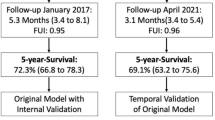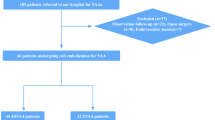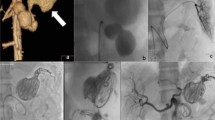Abstract
Despite improvements in diagnostic and therapeutic methods and an increased awareness of their clinical significance, abdominal aortic aneurysms (AAAs) continue to be a major source of morbidity and mortality. Endovascular repair of AAAs, initially described in 1990, offers a less-invasive alternative to conventional open repair. The technology and devices used for endovascular repair of AAAs have progressed rapidly and the approach has proven to be safe and effective in short to midterm investigations. Furthermore, several large trials have demonstrated that elective endovascular repair is associated with lower perioperative morbidity and mortality than open repair. The long-term benefits of endovascular repair relative to open repair, however, continue to be studied. In addition to elective repair, the use of endovascular repair for ruptured AAAs has been increasing, and has been shown to be associated with reduced perioperative morbidity and mortality. Advances in endovascular repair of AAAs, including the development of branched and fenestrated grafts and the use of implantable devices to measure aneurysm-sac pressures following stent-graft deployment, have further broadened the application of the technique and have enhanced postoperative monitoring. Despite these advances, endovascular repair of AAAs remains a relatively novel technique, and further long-term data need to be collected.
Key Points
-
Endovascular stent graft repair is a less-invasive technique than open surgery for the treatment of abdominal aortic aneurysms, involving relining of the diseased aorta instead of replacement, circumventing the need for major abdominal surgery and associated morbidity and mortality
-
Endovascular stent grafts have developed rapidly to include a variety of different devices and adjunctive technologies, which have broadened the spectrum of patients who are candidates for endovascular repair
-
The early results of the DREAM and EVAR 1 trials confirmed the benefits of endovascular repair compared with open repair; however, longer-term data are required as the durability of endovascular repair is a concern
-
Studies have shown that there is a correlation between lower sac pressures in patients with complete aneurysm exclusion and sac shrinkage over time, however, it is unclear whether measuring sac pressures will have a role in postoperative surveillance for patients who undergo endovascular aortic repair
-
The use of branched and fenestrated endovascular stent grafts might allow more patients to undergo endovascular repair; however, there are complications specific to the use of these devices
This is a preview of subscription content, access via your institution
Access options
Subscribe to this journal
Receive 12 print issues and online access
$209.00 per year
only $17.42 per issue
Buy this article
- Purchase on Springer Link
- Instant access to full article PDF
Prices may be subject to local taxes which are calculated during checkout





Similar content being viewed by others
References
National Center for Health Statistics (1991) Vital Statistics of the United States, 1988. Volume 2: Mortality. Part A. Washington, DC: Government Printing Office
Dubost C et al. (1952) Resection of aneurysm of abdominal aortic aorta: reestablishment of continuity by preserved human arterial graft, with result after five months. AMA Arch Surg 64: 405–408
Ernst CB (1993) Abdominal aortic aneurysm. N Engl J Med 328: 1167–1172
Parodi JC et al. (1991) Transfemoral intraluminal graft implantation for abdominal aortic aneurysms. Ann Vasc Surg 5: 491–499
D'Ayala M et al. (1998) Endovascular grafting for abdominal aortic aneurysms. Surg Clin North Am 78: 845–862
Chuter TAM et al. (1993) Transfemoral endovascular aortic graft placement. J Vasc Surg 18: 185–197
Criado FJ et al. (2000) Historical evolution of endovascular grafts for the treatment of aortic aneurysms. In Endovascular Grafting: Advanced Treatment for Vascular Disease, 1–6 (Eds Marin ML and Hollier LH) Armonk: Futura Publishing Company, Inc.
Marin ML et al. (1998) Impact of transrenal aortic endograft placement on endovascular graft repair of abdominal aortic aneurysms. J Vasc Surg 28: 638–646
Burks JA Jr et al. (2002) Endovascular repair of abdominal aortic aneurysms: stent-graft fixation across the visceral arteries. J Vasc Surg 35: 109–113
Parmer SS and Carpenter JP ; Endologix Investigators (2006) Endovascular aneurysm repair with suprarenal vs infrarenal fixation: a study of renal effects. J Vasc Surg 43: 19–25
Cayne NS et al. (2003) Does transrenal fixation of aortic endografts impair renal function? J Vasc Surg 38: 639–644
Matsumura JS et al. (2003) A multicenter controlled clinical trial of open versus endovascular treatment of abdominal aortic aneurysm. J Vasc Surg 37: 262–271
Moore WS et al. EVT/Guidant Investigators (2003) Five-year interim comparison of the Guidant bifurcated endograft with open repair of abdominal aortic aneurysm. J Vasc Surg 38: 46–55
Zarins CK et al. (1999) AneuRx stent graft versus open surgical repair of abdominal aortic aneurysms: multicenter prospective clinical trial. J Vasc Surg 29: 292–305
Hua HT et al. (2005) Early outcomes of endovascular versus open abdominal aortic aneurysm repair in the National Surgial Quality Improvement Program-Private Sector (NSQIP-PS). J Vasc Surg 41: 382–389
Bush RL et al. (2006) Open versus endovascular abdominal aortic aneurysm repair in VA hospitals. J Am Coll Surg 202: 577–587
Lee WA et al. (2004) Perioperative outcomes after open and endovascular repair of intact abdominal aortic aneurysms in the United States during 2001. J Vasc Surg 39: 491–496
Greenhalgh RM et al. EVAR trial participants (2004) Comparison of endovascular aneurysm repair with open repair in patients with abdominal aortic aneurysm (EVAR trial 1), 30-day operative mortality results: randomised controlled trial. Lancet 364: 843–848
Prinssen M et al. Dutch Randomized Endovascular Aneurysm Management (DREAM) Trial Group (2004) A randomized trial comparing conventional and endovascular repair of abdominal aortic aneurysms. N Engl J Med 351: 1607–1618
Blankensteijn JD et al. Dutch Randomized Endovascular Aneurysm Management (DREAM) Trial Group (2005) Two-year outcomes after conventional or endovascular repair of abdominal aortic aneurysms. N Engl J Med 352: 2398–2405
EVAR trial participants (2005) Endovascular aneurysm repair versus open repair in patients with abdominal aortic aneurysm (EVAR trial 1): randomised controlled trial. Lancet 365: 2179–2186
Yusuf SW et al. (1994) Emergency endovascular repair of leaking aortic aneurysm. Lancet 344: 1645
Hinchliffe RJ et al. (2001) Endovascular repair of ruptured abdominal aortic aneurysm—a challenge to open repair? Results of a single centre experience in 20 patients. Eur J Vasc Endovasc Surg 22: 528–534
Ohki T et al. (1999) Endovascular graft repair of ruptured aortoiliac aneurysms. J Am Coll Surg 189: 102–112
Yilmaz N et al. (2002) Emergency treatment of symptomatic or ruptured abdominal aortic aneurysms: the role of endovascular repair. J Endovasc Ther 9: 448–457
Lee WA et al. (2004) Impact of endovascular repair on early outcomes of ruptured abdominal aortic aneurysms. J Vasc Surg 40: 211–215
Alsac JM et al. (2005) Emergency endovascular repair for ruptured abdominal aortic aneurysms: feasibility and comparison of early results with conventional open repair. Eur J Vasc Endovasc Surg 30: 632–639
Larzon T et al. (2005) Endovascular treatment of ruptured abdominal aortic aneurysms: a shift of the paradigm? J Endovasc Ther 12: 548–555
Dillavou ED et al. (2006) Improving aneurysm-related outcomes: nationwide benefits of endovascular repair. J Vasc Surg 43: 446–451
Greco G et al. (2006) Outcomes of endovascular treatment of ruptured abdominal aortic aneurysms. J Vasc Surg 43: 453–459
Hechelhammer L et al. (2005) Midterm outcome of endovascular repair of ruptured abdominal aortic aneurysms. J Vasc Surg 41: 752–757
Inoue K et al. (1999) Aortic arch reconstruction by transluminally placed endovascular branched stent graft. Circulation 100 (Suppl II): II316–II321
Chuter TAM et al. (2003) Modular branched stent graft for endovascular repair of aortic arch aneurysm and dissection. J Vasc Surg 38: 859–863
Chuter TAM et al. (2001) Multi-branched stent-graft for type III thoracoabdominal aortic aneurysm. J Vasc Interv Radiol 12: 391–392
Bleyn J et al. (2002) Side-branched modular endograft system for thoracoabdominal aortic aneurysm repair. J Endovasc Ther 9: 838–841
Anderson JL et al. (2001) Endoluminal aortic grafting with renal and superior mesenteric artery incorporation by graft fenestration. J Endovasc Ther 8: 3–15
Greenberg RK et al. (2004) Endovascular management of juxtarenal aneurysms with fenestrated endovascular grafting. J Vasc Surg 39: 279–287
Abraham CZ et al. (2003) A modular multi-branched system for endovascular repair of bilateral common iliac artery aneurysms. J Endovasc Ther 10: 203–207
Iwase T et al. (1999) Transluminal repair of an infrarenal aortoiliac aneurysm by a combination of bifurcated and branched stent grafts. Cathet Cardiovasc Intervent 47: 491–494
Marin ML (2002) Covered stents: are they ready for prime time? Presented at Advanced Endovascular Therapies and All That Jazz: 2002 New Orleans, LA, USA
Haddad F et al. (2005) Fenestrated endovascular grafting: the renal side of the story. J Vasc Surg 41: 181–190
Baum RA et al. (2001) Aneurysm sac pressure measurements after endovascular repair of abdominal aortic aneurysms. J Vasc Surg 33: 32–41
Dias NV et al. (2004) Intra-aneurysm sac pressure measurements after endovascular aneurysm repair: differences between shrinking, unchanged, and expanding aneurysms with and without endoleaks. J Vasc Surg 39: 1229–1235
Ellozy SH et al. (2004) First experience in human beings with a permanently implantable intrasac pressure transducer for monitoring endovascular repair of abdominal aortic aneurysms. J Vasc Surg 40: 405–412
Ellozy SH et al. (2006) Abdominal aortic aneurysm sac shrinkage after endovascular aneurysm repair: correlation with chronic sac pressure measurement. J Vasc Surg 43: 2–7
Ohki T et al. (2005) Preliminary Outcome Of Wireless Pressure Sensing For EVAR (the Apex Trial). Presented at the Society for Vascular Surgery Annual Meeting: 2005 June 16–19, Chicago, IL, USA
Author information
Authors and Affiliations
Corresponding author
Ethics declarations
Competing interests
ML Marin is a scientific advisory board member for Remon Medical. The other authors declared they have no competing interests.
Rights and permissions
About this article
Cite this article
Baril, D., Jacobs, T. & Marin, M. Surgery Insight: advances in endovascular repair of abdominal aortic aneurysms. Nat Rev Cardiol 4, 206–213 (2007). https://doi.org/10.1038/ncpcardio0849
Issue Date:
DOI: https://doi.org/10.1038/ncpcardio0849



